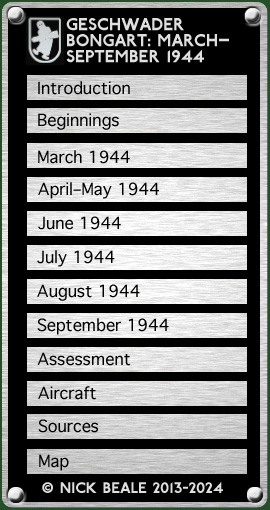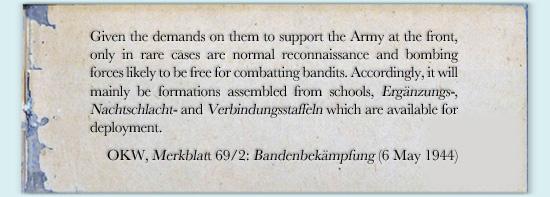|
Before sophisticated simulators existed, air defences — fighters, anti-aircraft guns, searchlights, observer posts, radar — needed live practice to be effective. This called for aerial targets to calibrate equipment on, to search for, to track and to shoot at and in the Luftwaffe this work was carried out by Luftdienstkommandos (air service detachments) whose aircraft were arriving in France as early as August 1940. Flak Brigades were told that the following would be available as the 2nd: a W. 34 at Argentan, a Bf 109 at Brest-Lanvéoc, an Ar 66 at Rennes and another at Tours. Moving on to 1944, on 27 January a Naval Liaison Officer signalled that an He 46 would be taking off from Nantes on a target flight off Saint Nazaire and an He 111 would carry out a similar task over the port that afternoon. Ofw. Wilhelm Paul, reportedly of 10./Fl.ZG 2 was injured when his He 46 E (W.Nr. 847) was caught by gusts when landing at Perpignan on 7 February but since the 10. Staffel did not yet exist (see below) it is likely that Paul was a member of its predecessor, Luftdienstkdo. Westfrankreich. On 20 April 1944 Luftdienst units in Germany, Belgium and Northern France were reorganised into three Fliegerzielgeschwader, filled out by some newly-created elements. The new FZG 2 consisted of a Stab and three Gruppen until a IV. Gruppe was added on the 29th and formation was to be completed by 15 May. On the 18th, a 13. Staffel was added to IV./Fl.ZG 2, with this measure to be completed within four weeks. The resulting structure of Gruppen (Roman numerals) and Staffeln (Arabic numerals) was:
Aerial “policing” (i.e. bombardment) of rebellious colonial populations had developed in the 1920s, with the RAF as a notable exponent. In the occupied USSR and Yugoslavia, the Luftwaffe had established formations to fight guerillas, the Behelfs- and Stör- Kampfstaffeln. This example was not followed in France, although sabotage and insurgency became an increasing problem after the German occupation of the Vichy zone in November 1942 and the imposition of compulsory labour service in February 1943. The opportunity was not taken in autumn 1943 to create a Nachtschlachtgeschwader in France when Luftflotte 2 in Italy was given one, presumably because no one yet saw a need. When an anti-partisan unit was finally established, the Luftwaffe instead turned to Fliegerzielgeschwader 2 (see above): Geschwader Bongart was formed out of its Stab, III. and IV. Gruppen but the new name was used alongside the old Gruppe and Staffel throughout the summer.
The then Maj. Freiherr von dem Bongart had come to British attention in mid-July 1940 thanks to three deciphered messages describing him as Liaison Officer of the “G.L.Z.” (General Luftzeugmeister = Head of Air Equipment). He was in Villacoublay SW of Paris to organise the introduction of bomber crewmen to the Lotfe 7C tachometric bomb sight, with a view to establishing a cadre of instructors at unit level. The first Gruppen taking part were II./KG 4, and I. and II./KG 55. On 18 July Bongart sent a request to the Air Ministry in Berlin to send by courier two of the sights “for instructional purposes”. I have no idea exactly when Luftwaffe aircraft were first used against the French Resistance, only that the means, motive and opportunity had been present from the moment that Maquisards first gave trouble in a rural area under German occupation. Once ground troops were sent against Résistants in rugged countryside, air support would have become valuable whether for reconnaissance or in an offensive role. The turning point seems to have been in early 1944 when the Wehrmacht (as opposed to the Vichy forces and the various German “security” services) began a succession of what it termed “cleansing” expeditions against regional Maquis groups. Guidelines for the use of air power in anti-partisan warfare formed part of a Wehrmacht handbook issued on 6 May to replace one concerned solely with the Eastern Front. continued on next page …
|
||||||||||||||||||||||||||||||||||||||||


